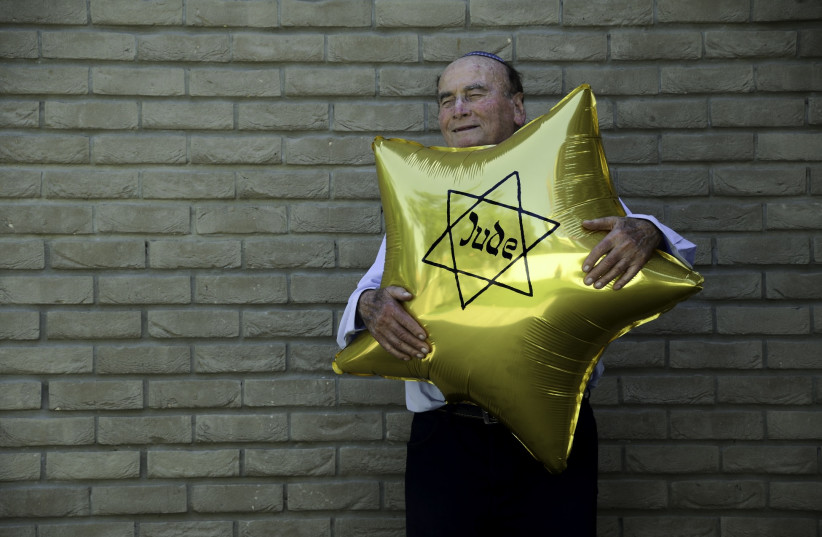In a striking photograph, an elderly man emerges, his head encircled by a powerful symbol of destruction - a ring of bullets, creating an image akin to swimming in a pool of ammunition. However, this man's story goes beyond the haunting image. Meet Michael Sidko, the last surviving witness of the harrowing Babyn Yar massacre.
His remarkable journey and resilience make him one of the central figures in the Humans of the Holocaust exhibit, which was launched last week, just a few minutes away from where the original Nazi Dachau concentration camp existed while killing tens of thousands of Jews.
The Humans of the Holocaust photo exhibit will be on display at the Max Mannheimer Haus in Dachau Germany until the beginning of August and is open to the public. Afterward, the exhibition will tour the seven Bavarian administrative districts this year and next year.
For this purpose, the Foundation for International Youth Exchange Bavaria selects secondary schools, high schools, vocational schools, youth education centers, and other public places that have a connection to the topic.
"Our goal is to inform young people about the Holocaust and to raise awareness for tolerance and respect, said Melanie Huml, Bavarian State Minister for European Affairs and International Affairs and chair of the board of Trustees of the Foundation for International Youth Exchange Bavaria last week at the opening of an exhibition about Holocaust survivors in Dachau.
Past, present, and future

“I am taking ownership of the symbol that turned me into a subhuman and turning it into an optimistic and smiling creation.”
- Dugo Litner
Huml added at the event that “With the connection between the exhibition and youth exchange, we are building a bridge between the past, the present, and the future. We encourage young people to actively stand up against antisemitism, racism, and all forms of intolerance. Getting to know each other and the culture of remembrance strengthens mutual understanding.”
She shared that during her trip to Israel at the end of last year, she understood that “due to Shoa we have the responsibility and obligation to keep the memory alive, especially for future generations, so that this never happens again."
Dachau, one of the earliest concentration camps established by the Nazis in 1933, stands as a chilling testament to the horrors of the Holocaust. Initially designed to imprison Hitler's political opponents, the camp expanded its scope to include forced labor and the incarceration of various groups, including Jews and Romani.
With nearly 100 sub-camps spread across southern Germany and Austria, Dachau became a symbol of unimaginable suffering and death. Today, the Dachau Memorial Site serves as a solemn place of remembrance, housing religious memorials and welcoming visitors to reflect upon this dark chapter in history.
The exhibition tells the extraordinary stories of 40 Holocaust survivors as well as second and third-generation survivors. The exhibition engages viewers with the human stories behind every photo, and by extension, helps them to imagine the millions of untold stories.
Kaganovitz, the photographer, told The Jerusalem Post in April that he started the Humans of the Holocaust project “after I saw a survey conducted by the Claims Conference that revealed that over two-thirds of millennials have never heard of Auschwitz and that half could not name a single concentration camp or ghetto.”
The stories behind the numbers
“Those numbers send a shiver down my spine, and I realized that I have to do something in order to better inform and educate people about the universal lessons of the Holocaust,” he said.
At the opening event of the exhibition, Kaganovitz shared with the audience that in his opinion, Millennials and Gen Z youth have a great curiosity about the subject of the Holocaust. I want to satisfy their curiosity about the exhibition. Therefore, I try to educate and inform young people about the lessons of the Holocaust in a contemporary way. The collected portraits are inspiring, very personal, and optimistic. They are portrayed in unexpected and moving ways. The stories have a global and universal message. You don't have to be Jewish to identify with them."
The Foundation for International Youth Exchange Bavaria was established by the Bavarian government in July 2021. The goal is to enable every young person in Bavaria to spend time abroad. For this aim, it develops and promotes innovative project and program formats with sponsors of international youth exchange and strengthens existing encounter programs with a focus on priority target groups and regions.
The Max Mannheimer Study Center is an extracurricular educational center that aims to provide young people from all over the world with an intensive examination of the Nazi era and the history of the Dachau concentration camp.
Dugo Litner, a survivor of Auschwitz-Birkenau, was photographed posing with a yellow-colored balloon in the shape of a Jewish star, and the word “Jude” was written on it.
Litner became famous in Israel, mainly among youngsters, since they annually celebrate the day he was freed from Auschwitz by eating a falafel, as he has been doing for decades. He is quoted in the exhibition saying that “I am taking ownership of the symbol that turned me into a subhuman and turning it into an optimistic and smiling creation.”
